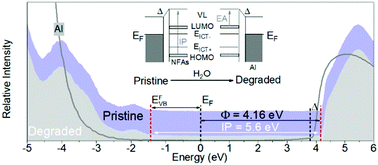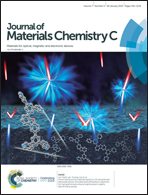Effects of water vapor and oxygen on non-fullerene small molecule acceptors†
Abstract
Due to the rapid development of non-fullerene acceptors (NFAs), the efficiency of organic solar cells is steadily being improved. The stability of organic solar cells also is expected to be enhanced with the introduction of the NFAs, yet the stability of NFAs themselves have been less investigated to date. In this paper, the stability of a set of typical NFAs was studied in situ employing photoelectron spectroscopy. The studied molecules show higher resistance to water vapor and thermal stress compared to fullerenes. For water vapor exposure, the highest occupied molecular orbital (HOMO) of NFAs undergoes only minor and reversible changes and the NFAs/substrate work function stays constant. Exposure to oxygen gas significantly modified the electronic structure of the NFAs and the effect was only partially reversible by annealing. However, the presence of water vapor was shown to slow down the degradation caused by oxygen. This is in stark contrast to fullerenes that undergo irreversible degradation upon water vapor exposure.



 Please wait while we load your content...
Please wait while we load your content...